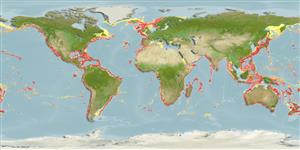Classification / Names
Common names from other countries
Main reference
Size / Weight / Age
Max length : 100.0 cm TL male/unsexed; (Ref. 26340); common length : 35.0 cm TL male/unsexed; (Ref. 9833); max. published weight: 2.5 kg (Ref. 9833)
Environment
Marine; bathydemersal; depth range 110 - 1000 m (Ref. 58302), usually 200 - 400 m (Ref. 35388)
Climate / Range
Deep-water, preferred 24°C (Ref. 107945); 70°N - 48°S, 180°W - 180°E
Distribution
Worldwide in temperate and tropical latitudes, except the eastern Pacific. Eastern Atlantic: Greenland, Iceland, and Norway to Western Sahara and South Africa, including western Mediterranean. Western Atlantic: south to Brazil. Also found in Argentine (Ref. 2806). Indo-Pacific: East Africa (including the Madascar Ridge and Saya de Malha Bank, Ref. 33390) to Japan, Australia, and New Zealand (Ref. 5755). The limited number of records in the western Pacific is doubtless the result of limited fishing effort below 200 m (Ref. 9833).
Countries | FAO areas | Ecosystems | Occurrences | Introductions
Short description
Dorsal
spines
(total): 4;
Dorsal
soft rays
(total): 18-20;
Anal
spines: 4;
Anal
soft rays: 25 - 30. Body deep, compressed and has a large eye. Top of head, iris, back and all fins bright blood red. Orbital bones, cheeks and opercular bones shiny white. Breast shiny yellowish white. Body silvery with thin lengthwise lines (Ref. 37108).
IUCN Red List Status (Ref. 115185)
Threat to humans
Harmless
Human uses
Fisheries: commercial
More information
ReferencesAquacultureAquaculture profileStrainsGeneticsAllele frequenciesHeritabilityDiseasesProcessingMass conversion
Tools
Special reports
Download XML
Internet sources
Estimates of some properties based on models
Phylogenetic diversity index
PD50 = 0.6260 many relatives (e.g. carps) 0.5 - 2.0 few relatives (e.g. lungfishes)
Trophic Level
4.1 ±0.76 se; Based on food items.
Resilience
Low, minimum population doubling time 4.5 - 14 years (K = 0.11-0.16; tmax >11)
Vulnerability
High to very high vulnerability (72 of 100)
Price category
